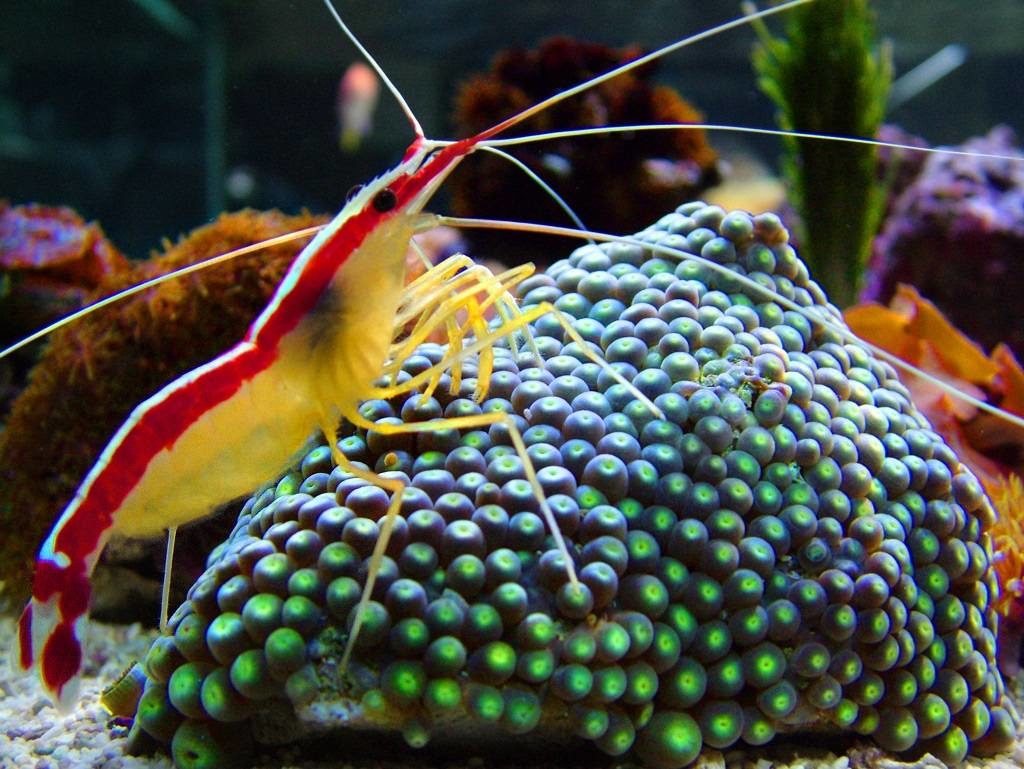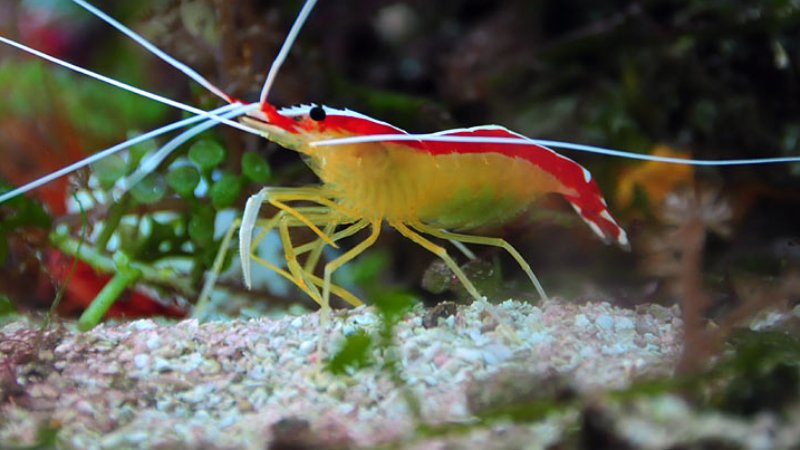Cleaner shrimp eggs are a type of cleaner fish that feed on parasites and unwanted organisms found in marine animals. The cleaner shrimp’s diet is similar to that of cleaner wrasse, but with cleaner shrimp being smaller in size. Cleaner shrimp can also be called “prawns” because they resemble prawns with large antennae and small bodies.
The cleaner shrimp eggs have been used for many years as bait by fishers for other species such as tuna, marlin, swordfish, and even sharks!
See also:
- How Is Cleaner Shrimp Molting? 5 Facts About Cleaner Shrimp.
- How To Trap A Mantis Shrimp Successfully?
Cleaner Shrimp Eggs
A shrimp’s abdomen curls severely during egg extrusion, and new eggs are attached to the “hairs” behind the four pairs of pleopods behind the first pair, which forms the second pair. In this case, the abdomen of the adult appears to have four columns of eggs. At first, the eggs are green and densely packed near the body. The adult regularly carries out waves of pleopods and aeration of the eggs. Occasionally, the adult eats something picked from the egg mass. It gathers at the egg mass frequently.
Midway through the 14-20 day incubation period, the eggs change from a bright green to a light amber colour similar to the underside of the adult. During the transition from green to pale amber, the eggs spread out on the pleopods, and they appear as an indistinct mound of eggs once they are aligned in neat columns. When the pile of eggs reaches the end of incubation, the adult pleopods must remain partially open due to the increasing bulk as the eggs lighten in colour and expand in volume. During the hatching process, a few eggs turn dull silver. Just before hatching, the oval-shaped eggs measure 1.2 millimetres long and 0.6 millimetres wide.
If you’ve bred clownfish, you’ve likely noticed that the silver colour of Lysmata eggs before hatching is not as shimmery as the silver colour observed when light reflects from the developing eye pigment of clownfish eggs on the day of hatching. This is because all Lysmata species have compound eyes, which scatter reflected light in various directions. There are tiny lenses inside each compound eye, each with a fixed focal distance. Crustaceans’ compound eyes offer a bright but blurred view of the world. It must be just like living inside a kaleidoscope for tiny compound-eyed larvae as they move through the water currents, seeing images that come in and out of focus.
As soon as a few eggs develop the silver colour, the cleaner shrimp can be transferred into the larval rearing tank. Besides the silver egg colour, the shrimp’s refusal to eat in the evening is another indication that the eggs will hatch that night. (Feeding shrimp while in a rearing tank is not recommended as it can pollute the tank water). The larvae hatch from the open pleopods once the adult is in a good current. Adult shrimp jump from surface to surface while sweeping their extended abdomens forward to help larvae escape if the wind is unfavourable. The larvae in the hatching tank can free themselves from the pleopods by a mild water current. After the larvae are launched on their larval journey, the adults molt. A recently lost shrimp with broken antennae provides a clue to the hobbyist to add iodine to the aquarium. It is essential to return the adult to its main tank the following morning after the larvae hatch. The exoskeleton will be soft, and the coupling of the shrimp may occur within a few minutes of their reunion. Transferring adult shrimp from one tank to another requires careful acclimation.
My shrimp would molt whenever they moved, even if they were ready to hatch or not, but the premature molting ended when both of them were moved to a rearing tank. It seems that my shrimp is scared out of its exoskeleton whenever it is separated from its mate.
A molt that had been prematurely abandoned, with its eggs still attached, was examined under a microscope, and numerous partially hatched eggs and odd-looking pleopods were found. There were appendages, hairs, and tiny spikes all over the place. Larvae were designed to grab anything soft that came near them. It could be said that the little creatures resemble escaped sketches from an imaginative Velcro designer’s sketchbook. The creatures would have been frightful if they weren’t so small.
Nauplius, the first stage of larval development in crustaceans, appears to exist within the egg of Lysmata amboinensis. The nuclear appendages of nauplii are three. There are three appendages: the first and second antennae and the mandibles (mouth appendages). The nauplius stage is a swimming, pelagic stage in some crustaceans, including brine shrimp. However, several crustaceans develop within the egg before reaching nauplius. In addition to their three appendages upon hatching, Scarlet Cleaner shrimp larvae seem to have completed the nauplius stage before hatching.
Cleaner Shrimp Eggs Production Frequency
We isolated two shrimp for close observation. The size, shape, and colour of mature Scarlet Cleaner shrimp are all similar. However, the form of the white spots and the inverted “T” on the tail fan is unique to each shrimp and assist in identifying them.

Every 14 days, each shrimp molted and produced a new clutch of eggs. Molting and egg-laying cycles sometimes lasted 16 days. Occasionally, the process exceeded 20 days. After tank cleanings and water changes, the egg carrying cycle is longer.
The shrimp’s egg production cycles were about seven days apart from each other. Therefore, each shrimp spawned about halfway through the other shrimp’s egg-laying process. Every Saturday morning, one or the other of the pair laid fresh eggs.
Shrimps Carry Their Eggs
Shrimps carry their eggs on their underside, unlike most fish, which lay eggs or retain eggs inside the body to give birth. When a shrimp takes eggs, it is called a berried shrimp.
When she is ready to breed, the female releases sexual hormones into the water, when the male finds her, he will deposit his sperm on her, who will then pass the eggs underneath her tail.
The shrimp’s tail constantly fans the eggs until they hatch. They need oxygen, just like adult shrimp, so fanning helps them. Fanning ensures that mold and bacteria do not grow on eggs.
It is pretty fascinating to see their eggs since they are usually visible to the naked eye. Shrimps such as cherry shrimp are extremely easy to breed in aquariums, whereas shrimps such as Amano shrimp are much more difficult.
FAQs
Can cleaner shrimp fertilize their eggs?
Cleaner shrimp (Lysmata amboinensis) pairs make their living picking parasites from fish. Each shrimp is a hermaphrodite, meaning it can reproduce as both a male and a female, though it can’t fertilize its eggs.
Will cleaner shrimp eat clownfish eggs?
No worries. They are not killers. A shrimp can’t physically ingest an entire clownfish.
How long does a cleaner shrimp live?
Typically long-lived critters, Skunk Cleaner Shrimps may live up to 3 years or longer.
Conclusion
Cleaner shrimp eggs are an excellent food source for many animals, such as cleaner fish, mantis shrimp, and the occasional human. The cleaner shrimp is known to eat parasites off of other marine life while they swim by. Cleaner shrimp can also be found in aquariums, where they clean algae off glass tanks and coral reefs. These amazing creatures have an even more unique ability that sets them apart from their counterparts; they produce their own eggs!

Annette M. Chaney is an experienced marine biologist with over 20 years of experience as an aquarist and fishkeeper. She started her first aquarium at a young age, filling it with frogs and goldfish obtained from the ten-cent pet store.
Annette grew up caring for and breeding African Cichlids, which led to a hobby in high school that doubled as a profitable means. Attending Reed College gave her time to solidify herself as an accomplished aquarium caretaker with an eye for sales. After that, from 2009 – 2013, she studied at Roger Williams University – one of the most prestigious universities for Aquaculture and Aquarium in USA. She is the founder of AquariumCircle since 2010.
